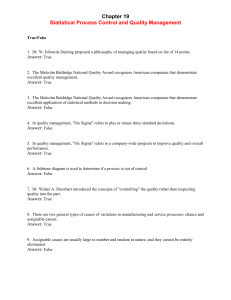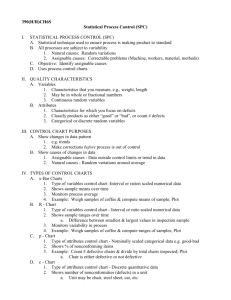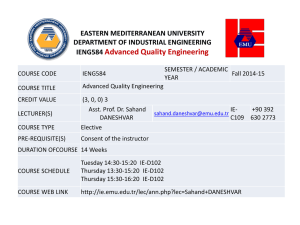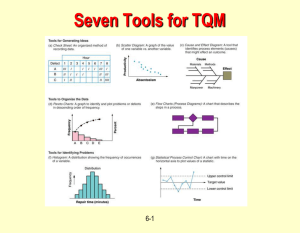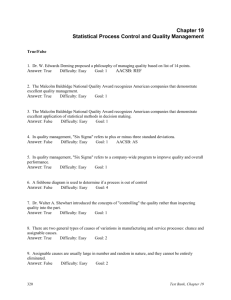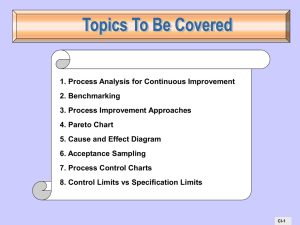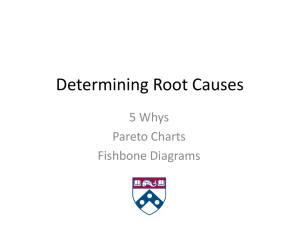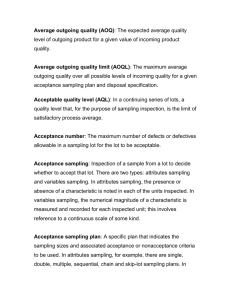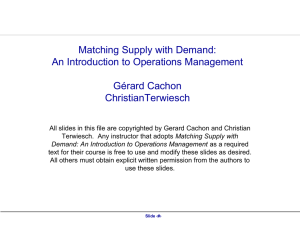Chapter 19 Statistical Process Control and Quality Management
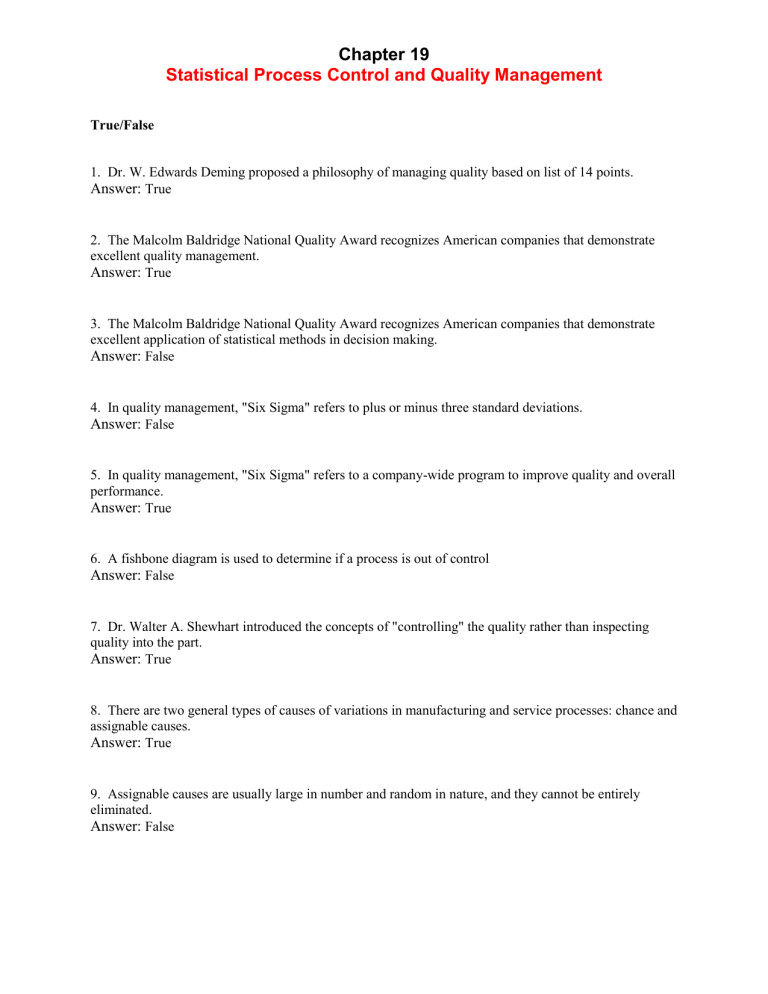
Chapter 19
Statistical Process Control and Quality Management
True/False
1. Dr. W. Edwards Deming proposed a philosophy of managing quality based on list of 14 points.
Answer: True
2. The Malcolm Baldridge National Quality Award recognizes American companies that demonstrate excellent quality management.
Answer: True
3. The Malcolm Baldridge National Quality Award recognizes American companies that demonstrate excellent application of statistical methods in decision making.
Answer: False
4. In quality management, "Six Sigma" refers to plus or minus three standard deviations.
Answer: False
5. In quality management, "Six Sigma" refers to a company-wide program to improve quality and overall performance.
Answer: True
6. A fishbone diagram is used to determine if a process is out of control
Answer: False
7. Dr. Walter A. Shewhart introduced the concepts of "controlling" the quality rather than inspecting quality into the part.
Answer: True
8. There are two general types of causes of variations in manufacturing and service processes: chance and assignable causes.
Answer: True
9. Assignable causes are usually large in number and random in nature, and they cannot be entirely eliminated.
Answer: False
10. Chance causes of variation are usually few in number and not random in nature, and they can be readily identified, and reduced or eliminated.
Answer: False
11. Assignable causes can generally be corrected easily, while chance causes cannot usually be corrected or stabilized economically.
Answer: True
12. The purpose of a statistical quality control chart is to identify when assignable causes of variation have entered the production system so that the cause may be identified and corrected.
Answer: True
13. Pareto charts can be used to identify and diagnose chance causes of variation in a manufacturing or service process.
Answer: False
14. Pareto charts can be used to identify and diagnose assignable causes of variation in a manufacturing or service process.
Answer: True
15. Pareto charts are based on the 80-20 rule, which says, 80% of the problem is caused by 20% of the factors.
Answer: True
16. Pareto charts are based on the 80-20 rule, which says, 80% of the factors cause 20% of the problem.
Answer: False
17. Quality control charts indicate whether a production process is in control or out of control.
Answer: True
18. Control charts can be developed for both variables and attributes.
Answer: True
19. Mean charts are designed to determine whether a process is in or out of control based on sample means.
Answer: True
20. Summing the means of the samples and dividing that sum by the number of sample means can compute the mean of an X bar chart.
Answer: True
21. The purpose of a mean chart is to portray the fluctuations in the sample means.
Answer: True
22. The upper control limit (UCL) and the lower control limit (LCL) of a chart report the limits of the variation expected by chance.
Answer: True
23. Mean charts use sample ranges to determine if the process is in or out of control.
Answer: False
24. For a range chart with control limits set at ± 3ó, about 997 sample ranges out of 1,000 will fall between the upper and lower control limits.
Answer: True
25. A range chart shows variation in the ranges of the samples.
Answer: True
26. If one sample range should fall outside the control limits, it is very likely that some assignable cause affected the production.
Answer: True
27. If one sample range should fall outside the control limits, it is very unlikely that some chance event affected the production.
Answer: True
28. Percent defective charts, which are also known as P charts or p bar charts, show the percent of the production that is or is not acceptable.
Answer: True
29. A c bar chart shows the percent of the production that is defective.
Answer: False
30. The following are examples of attributes: A weld has a crack in it or it doesn't; a relay works or it doesn't; a radiator leaks or it doesn't; the lock on a car door works or it doesn't; a tire fits on the rim or it doesn't.
Answer: True
31. The following are examples of attributes: the width of a cracked weld, the length of time that a relay works; the amount of water in a radiator, the diameter of a tire.
Answer: False
32. The following are examples of variables: the width of a cracked weld, the length of time that a relay works; the amount of water in a radiator, the diameter of a tire.
Answer: True
33. The purpose of a c bar chart is to show how many defects appear in a unit of production.
Answer: True
34. A value of 4.0 is recorded on the centerline of a c bar chart. This indicates that the lowest number of defects per unit is 4.0.
Answer: False
35. Chance causes of variation cannot be entirely eliminated.
Answer: True
36. In acceptance sampling, usually 100% of the incoming lot is checked.
Answer: False
37. In acceptance sampling, if the number of defects in a sample is less or equal to the acceptance number, then the incoming lot is accepted.
Answer: True
Multiple Choice
38. Samples of 200 parts were taken every day and the number of defectives was counted. What are the upper and lower limits for the percent defective chart?
Day 1 2 3 4
Number Defective 4 3 5 4
A) 0.02 and 0
B) 0.2970 and 0
C) 0.0297 and 0
D) 0.0497 and 0
Answer: D
39. A subassembly is inspected and the number of defects recorded. A new group of assemblers began work Monday morning. The number of defects per subassembly for the first 10 they produced was: 3, 2,
0, 5, 4, 6, 0, 7, 7, and 6. What are the upper and lower limits for the c bar chart?
A) 15 and 0
B) 10 and 0
C) 1.12 and 0
D) 6 and –2
Answer: B
40. What is usually developed to evaluate a sampling plan?
A) Frequency polygon
B) Scatter diagram
C) Operating characteristic curve
D) Simple bar chart
Answer: C
41. Which probability distribution is used to develop a percent defective chart?
A) Normal distribution
B) Chi-square distribution
C) Mann-Whitney test
D) Binomial distribution
Answer: D
42. Which probability distribution is used to develop a control chart for sample means?
A) Normal distribution
B) Chi-square distribution
C) Mann-Whitney test
D) Binomial distribution
Answer: A
43. Which probability distribution is used to develop an operating characteristic curve?
A) Normal distribution
B) Chi-square distribution
C) Mann-Whitney test
D) Binomial distribution
Answer: D
44. If the weather forecast says that there will be a 20% chance of rain, what type of variation would rain be an example?
A) Chance
B) External
C) Assignable
D) Standard variation
Answer: A
45. If the weather forecast says that there will be a 100% chance of rain, what type of variation would rain be an example?
A) Chance
B) External
C) Assignable
D) Standard variation
Answer: C
46. A sampling plan states that if 20 incoming transistors are checked and 2 or less defects are found that the lot is accepted. If an incoming lot is 10 percent defective, what is the probability of accepting the lot of transistors?
A) 0
B) 1
C) 0.037
D) 0.667
E) 0.333
Answer: D
47. A sampling plan states that if 20 incoming bolts are checked and 2 or less defective bolts are discovered the lot will be rejected. If an incoming lot is 10 percent defective, what is the probability of rejecting the lot?
A) 0
B) 1
C) 0.333
D) 0.667
Answer: C
48. Cappelli Inc. designs and manufactures women's apparel using material from various mills. Their acceptance sampling plan states that 20 two inch squares of the incoming material must be carefully checked. If 3 or less squares reveal imperfections, the lot is accepted. What is the probability that an incoming lot from Blufton Mills that contains 40 percent imperfect cloth will be accepted?
A) 0
B) 0.239
C) 0.015
D) 0.0024
Answer: C
49. What is the process that insures that a company is producing a quality product or service?
A) SPC
B) Pareto analysis
C) Fishbone chart analysis
D) Diagnostic chart
Answer: A
50. What chart helps to identify the relatively few factors that impact the performance of a manufacturing or service process?
A) SPC
B) Pareto analysis
C) Fishbone chart analysis
D) Diagnostic chart
Answer: B
51. What process investigates the potential causes of an outcome or effect such as poor quality?
A) SPC
B) Pareto analysis
C) Fishbone chart analysis
D) Diagnostic chart
Answer: C
52. A fishbone diagram classifies potential causes into categories. What are they?
A) Chance and assignable variation
B) Methods, materials, equipment, and personnel
C) Percent defective and percent non-defective
D) Causes and effects
Answer: B
53. What type of variation can be reduced, or even eliminated, and is usually nonrandom in nature?
A) Chance
B) External
C) Assignable
D) Co-variation
Answer: C
54. Equipment failure would be an example of ____________ variation.
A) chance
B) external
C) assignable
D) standard variation
Answer: C
55. The technique that tallies types of defects and their frequency is called
A) range charts.
B) Pareto analysis.
C) control charts.
D) fishbone diagram.
Answer: B
56. A chart used to show the results of a Pareto analysis is a
A) Range chart.
B) Bar chart.
C) Control chart.
D) Fishbone diagram.
Answer: B
57. The cause-and-effect chart is an example of a
A) range chart.
B) Pareto chart.
C) control chart.
D) fishbone diagram.
Answer: D
58. In a control chart, expected variation is defined by the
A) standard deviation.
B) standard error of the distribution.
C) only upper control limits.
D) upper and lower control limits.
Answer: D
59. Control charts are used to determine if a process is
A) in or out of control.
B) measurable.
C) fixable.
D) testable.
Answer: A
60. The Quality Assurance Department selected a sample of 12 printed circuit boards and tested them.
The number of defects in each circuit board was 3, 3, 0, 5, 1, 1, 5, 6, 6, 2, 0, and 1. What kind of control chart should be constructed to monitor the process?
A) Mean chart
B) Range chart
C) Percent defective chart
D) C-bar chart
Answer: D
61. The Quality Assurance Department selected 12 samples of 100 printed circuit boards and tested them.
The number of defective printed circuit boards in each sample was 3, 3, 0, 5, 1, 1, 5, 6, 6, 2, 0, and 1.
What kind of control chart should be constructed to monitor the process?
A) Mean chart
B) Range chart
C) Percent defective chart
D) C-bar chart
Answer: C
62. The upper and lower control limits are usually set at
A) the mean.
B) above the mean.
C) 3 standard deviations from the mean.
D) 2 standard deviations from the mean.
Answer: C
63. If the upper and lower control limits are set at
3 standard deviations from the mean, we would expect that
A) 99.7% of the sample means are within the control limits
B) 95% of the sample means are within the control limits
C) about 68% of the sample means are within the control limits
D) about 5% of the sample means are outside the control limits
Answer: A
Fill-in-the-Blank
64. Which chart portrays the number of defects per unit of production? _____________
Answer: c bar
65. In an acceptance sampling plan, what happens to the incoming lot if the number of defective items in the sample is less than or equal to the acceptance number? __________________
Answer: The lot is accepted.
66. In acceptance sampling, it is possible that an incoming lot of computer chips contains more defective chips than it should, but it is accepted. In acceptance sampling, what is this probability call? _______
Answer: consumers risk
67. If the binomial distribution is used to develop an operating characteristic curve for an acceptance sampling plan, then it is imperative that the trials be ________________
Answer: independent
68. If the binomial distribution is used to develop an operating characteristic curve for an acceptance sampling plan, how many possible outcomes can there be? _______
Answer: two
69. In what decade were the concepts of statistical quality control developed?________
Answer: 1920's
70. One of the most important concepts of statistical process control is that no two products are
________________
Answer: identical
71. What does a statistical quality control chart identify? ____________
Answer: assignable variation
72. Acceptance sampling and control charts may be based on measurements with either ______________ or ____________________.
Answer: variables or attributes
73. What is the purpose of the mean chart? _______________________________
Answer: To show the variation in sample means
74. How is the mean of the sample means designated? _______
Answer: X double bar
75. A range chart shows variation of _____________ .
Answer: sample ranges
76. If the sample ranges fall randomly within the upper and lower control limits, then it can be assumed that production is ____________ .
Answer: in control
77. A p-bar chart graphs the portion of production that is not acceptable based on random samples. What is another name for the p-bar chart? ______________
Answer: percent defective chart
78. What chart portrays the number of defects per unit? ____________
Answer: c-bar
79. What is the "in control" region of a control chart called? ____________________
Answer: the acceptance region
80. What causes of variation cannot be entirely eliminated? _____________
Answer: chance
81. What variation is due to slight changes in materials or process conditions and is random in nature?
________________
Answer: chance
Multiple Choice
Use the following to answer questions 82-98:
A new machine is set or calibrated to fill tubes of toothpaste at precisely 6.75 ounces. Then, once the machine is running, a sample of 6 tubes is taken every three hours and weighed with the following results:
WEIGHT OF TOOTHPASTE
TIME
7 am
10 am
1 pm
4 pm
7 pm
6.69
6.71
6.66
6.73
6.75
6.68
6.72
6.68
6.74
6.73
6.79
6.71
6.67
6.72
6.75
6.77
6.76
6.71
6.76
6.77
6.74
6.75
6.76
6.78
6.79
6.76
6.74
6.78
6.75
6.75
82. If the mean of the ranges is 0.08, what is the value of the upper control limit (UCL) for the range?
A) 0.000
B) 0.160
C) 0.169
D) 0.203
Answer: B
83. If the mean of the ranges is 0.08, what is the value for the lower control limit (LCL) of the range?
A) 0.00
B) 0.080
C) 0.186
D) 0.203
Answer: A
84. What is X bar for 7 am?
A) 6.72
B) 6.74
C) 6.78
D) 6.80
Answer: B
85. What is X bar for 10 am?
A) 6.73
B) 6.74
C) 6.75
D) 6.76
Answer: A
86. What is X bar for 1 pm?
A) 6.73
B) 6.74
C) 6.75
D) 6.71
Answer: D
87. What is X bar for 4 pm?
A) 6.73
B) 6.74
C) 6.75
D) 6.80
Answer: C
88. What is X bar for 7 pm?
A) 6.71
B) 6.72
C) 6.74
D) 6.76
Answer: D
89. What is the value of A
2
, the control limit factor for averages?
A) 0
B) 1
C) 0.577
D) 0.483
Answer: D
90. What is the range of the samples at 7 am?
A) 0.05
B) 0.06
C) 0.11
D) 0.12
Answer: C
91. What is the range of the samples at 10 am?
A) 0.05
B) 0.06
C) 0.11
D) 0.12
Answer: A
92. What is the range of the samples at 1 pm?
A) 0.05
B) 0.06
C) 0.11
D) 0.12
Answer: D
93. What is the range of the samples at 4 pm?
A) 0.05
B) 0.06
C) 0.11
D) 0.12
Answer: B
94. What is the range of the samples at 7 pm?
A) 0.05
B) 0.06
C) 0.11
D) 0.12
Answer: B
95. What is the value of the upper control factor of the range?
A) 0
B) 2.115
C) 2.004
D) 3.0
Answer: C
96. What is the value of the lower control factor of the range?
A) 0
B) 2.115
C) 2.004
D) 3.0
Answer: A
97. If the mean of the sample means is 6.738 and R bar is 0.08, what is the upper control limit (UCL)?
A) 6.738
B) 6.999
C) 6.777
D) 7.221
Answer: C
98. If the mean of the sample means is 6.738 and R bar is 0.08, what is the lower control limit?
A) 6.738
B) 6.669
C) 6.699
D) 6.255
Answer: C
Use the following to answer questions 99-100:
Every half hour, the quality control inspector checks a process by measuring four pieces and records the outside diameters of each of them, as shown below.
SAMPLE PIECE
1 2 3 4
TIME
9:00 AM
9:30 AM
10:00 AM
1
2
1
4
3
7
99. What are the upper and lower control limits of the mean chart?
A) 5.916. and 0
B) 5.916 and 0.084
C) 0.729 and 0
D) 4 and 0
Answer: B
5
2
3
2
1
5
100. What are the upper and lower limits of the range chart?
A) 9.128 and 0
B) 2.282 and 4
C) 2.282 and 0
D) 100 and 0
Answer: A
Use the following to answer questions 101-103:
A new machine used in the production of motor mount bolts was put into operation. Five samples of size
100 were randomly selected and the number of defectives in each sample was noted.
Defectives
Sample
1
3
2
1
3
3
4
4
5
2
101. What is the average percent defective?
A) 2.0%
B) 2.3%
C) 2.6%
D) 2.9%
Answer: C
102. What is the upper control limit (UCL)?
A) 0.067
B) 0.074
C) 0.081
D) 1.000
Answer: B
103. What is the lower control limit (LCL)?
A) 0
B) –0.022
C) 0.048
D) 0.160
Answer: A
Use the following to answer questions 104-107:
Subgroups of 4 items each are taken from a manufacturing process at regular intervals and a certain quality characteristic is measured. After 25 subgroups,
X
15 , 350 and
R
411.4
.
104. What is the value of the means?
A) 15,350
B) 614
C) 411.4
D) 3837.5
Answer: B
105. What is the value for R bar?
A) 411.4
B) 614
C) 16.46
D) 102.88
Answer: C
Fill-in-the-Blank
106. What is the upper control limit (UCL) for the mean? _____
Answer: 625.996
107. What is the lower control limit (LCL) for the mean? _______
Answer: 602.004
Essay
108. The manager of a restaurant surveys customer satisfaction as they leave the restaurant. Is this an example of acceptance sampling or statistical process control? Explain why.
Answer: This is an example of acceptance sampling. The measurement of quality happens after the service has been completed.
109. The manager of a restaurant measures several variables important to quality. These include: food temperature, time to complete an order, and number of times a server visits a table. These variables are graphed over time. Is this an example of acceptance sampling or statistical process control?
Answer: This is an example of statistical process control. Several measures of process quality are measured over time. Any unusual measurements will be detected in a timely fashion and the process can be corrected.
110. Explain the risks of acceptance sampling.
Answer: There are two risks or acceptance sampling: consumer’s risk and producer’s risk. In acceptance sampling, a decision to accept a batch of products is based on the inspection of a sample. Based on the sample, if the sample of products is acceptable, then we make an inference that the entire batch is acceptable. However, if this inference is incorrect, then this is consumer’s risk, i.e., we accept a batch that is not acceptable. In contrast, if the sample of products is unacceptable, then we make an inference that the entire batch is unacceptable. However, if this inference is incorrect, then this is producer’s risk, we rejected a batch that is acceptable.
